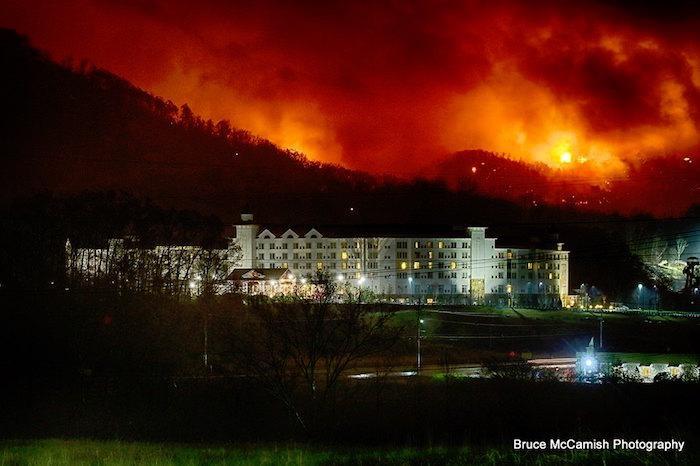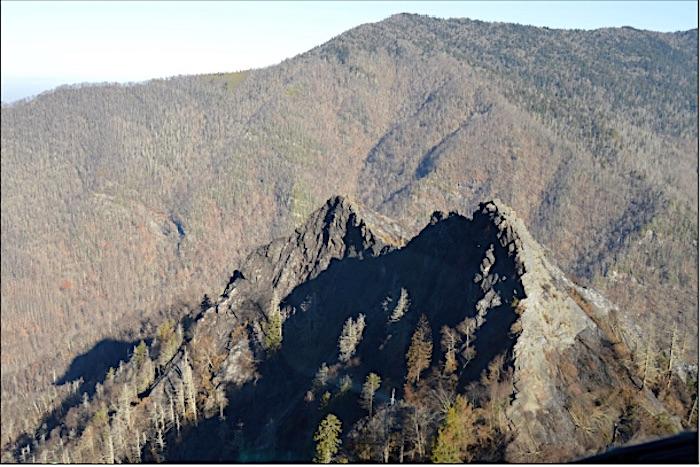
A review panel found faults with how Great Smoky Mountains National Park staff attacked the deadly Chimney Tops 2 Fire last fall, but no "wanton disregard or negligence" on the park's behalf/Bruce McCamish
A deadly fire fed by kindling-dry forests and whipped out of control by hurricane-force winds at Great Smoky Mountains National Park "overwhelmed" the park staff's ability to fight it, according to an independent review of the blaze that killed 14 in neighboring communities.
Additionally, the fire management officer did not closely following the park's fire management plan, and Superintendent Cassius Cash did not act to see that the plan was followed.
The fire was spotted shortly before 5:30 p.m. last November 23 near the end of the Chimney Tops Trail atop one of the many steep ridges of on the Tennessee side of the park. Greg Salansky, the park's fire management officer, hiked about two miles up to the fire and quickly decided it was unsafe due to the steepness, and fading daylight, to attack the flames until the next morning, Thanksgiving Day.
That was the correct decision, the review board concluded.
"The risk of injury or worse to a firefighter was extremely high while the probability of success in containing the fire was impossible with the resource staffing," it noted. "At the point of ignition, the slopes were extremely steep and near vertical and it was dark when the (fire management officer) arrived on scene."
But with extreme drought conditions across the Southeast, and many other fires in the region, getting enough resources on the so-called Chimney Tops 2 Fire posed a problem.
“The fire is approximately two acres on the northeast side of the second summit. The fire is smoldering and creeping around. The area is too steep for attack. Will consider Air Ops tomorrow. It is unknown if [Fire Management Officer] could even get aircraft with all of the other fires," Great Smoky's chief ranger wrote in a text to the deputy superintendent on Thanksgiving Day.
For the first few days the fire didn't expand too much, smoldering in forest duff and covering roughly 8 acres four days after it had been spotted. But the rugged landscape hindered ground crews from digging containment lines amid the cliffs and gullies, and cloud cover at times prevented water drops.

The two peaks known as Chimney Tops in Great Smoky Mountains National Park/NPS
Extreme drought conditions and heavy ground fuels -- downed and dead hemlocks among them -- initially fed the fire, and then hurricane-force winds on November 28 into November 29 blew the conflagration into a firestorm that swept through Gatlinburg, Tennessee, trapping many in their homes and destroying or damaging approximately 2,500 structures. Power lines downed by the winds and sparking transformers set additional fires in the town. When it was all over, 14 deaths had been reported.
The impact of the drought was substantial. The drought resulted in lower moisture contents of not only dead fuels such as leaves, sticks, logs, and duff, but live vegetation as well. In drought-free years, duff, large logs, and live vegetation such as understory shrubs are much less flammable. The addition of these fuels to a wildland fire increases its intensity and makes it more difficult to control. In addition to the drought-stricken fuels, the normal autumn leaf fall was underway in the widespread deciduous forest. With below average rainfall amount and frequency, this litter layer—normally somewhat compacted by moisture—remained uncompressed and subject to movement by winds.
Mr. Salansky had contacted the captain of the Gatlinburg Fire Department the morning of November 28 "to let him know about this wildland fire and the potential for its smoke to travel to the city," the investigation's 116-page report noted.
After a spot fire was reported near the park's Twin Peaks Picnic Pavillion, roughly 1.5 miles from Gatlinburg, the Tennessee Division of Forestry was asked to send two bulldozers to Mynatt Park, a subdivision within Gatlinburg not far from the picnic pavillion, and the Gatlinburg Fire Department was asked to respond to protect structures inside the park.
While aircraft were asked to attack the fire with water drops, "due to extreme wind turbulence (the aircraft), had to abort this second flight half way there—thereby cancelling out any helicopter or fixed-wing aviation assistance."
By early afternoon on November 28 there were reports of spot fires flaring up 5 miles from the main fire reported to be burning at the Chimneys Picnic Area, the Bullhead Spur area north of Newfound Gap Road, and Twin Creeks.
The increasing, erratic winds were creating unprecedented fire conditions, the report indicated. According to the fire management officer's discussion with investigators, the blaze "jumped road, jumped trails, jumped wet drainages and wide creeks. I mean there was no natural barrier” and “there’s no way this stuff could be humanly stopped.”
Officials later said the wildfires originated from multiple locations, including an arson fire set at Chimney Tops inside the park, and from downed power line ignitions throughout Sevier County. Fueled by extreme winds and dry weather, the fire storm also injured 190. In all, losses attributed to the fire have been estimated at $500 million.

When conditions allowed, air support was called in to make water drops on the blaze/NPS
The review board concluded that the "unprecedented Chimney Tops 2 Fire event exposed several wildland fire situational preparedness and planning weaknesses at the Great Smoky Mountains National Park. Despite these weaknesses, the review team found no evidence of wanton disregard or negligence by anyone at the park."
"What was unprecedented was the combination of a severe wind event (a “mountain wave” extreme wind that usually occurs 2-4 times per year from November through March in the western foothills of the southern Appalachian Mountains), coupled with severe drought and a wildland fire on the landscape," it added. "This scenario had never been witnessed by anyone at the park."
Two juveniles initially had been charged with arson in connection with the blaze, but Tennessee authorities later dropped the charges, saying they couldn't directly tie the Chimney Tops 2 fire in the national park with the subsequent fires in and around Gatlinburg.
"... the State’s cause is further complicated by the fact that there were other fires in the area and other confirmed ignition points in the Gatlinburg area from multiple downed power lines that were felled by the wind," Fourth Judicial District (Tennessee) Attorney General Jimmy Dunn said in explaining the decision. "Some of these fires appear to have erupted prior to the fire from the Park breaching the Gatlinburg city limits. Once the investigation confirmed multiple fires with multiple points of origin, it became impossible to prove which fire may have caused the death of an individual or damage to a particular structure."
Federal authorities have not charged the teens for starting the fire inside the park.
The purpose of the review team was to identify the facts leading up to and during the Chimney Tops 2 fire within the boundaries of the national park, as well as to make recommendations on any planning, operational, or managerial issues that can be addressed locally, regionally, and/or nationally to reduce the chances of a similar incident in the future.
Among the review team's findings were that:
- The park’s fire management officer did not follow the direction of the fire management plan to staff with duty officers and additional support functions.
- The park’s leadership did not ensure that the fire management plan was followed. Throughout the initial days of the firefighting the park failed to coordinate with Tennessee and North Carolina Divisions of Forestry, Cherokee Bureau of Indian Affairs (BIA), and Cherokee National Forest.
- Support functions for the firefighting effort were not fully in place
Among the team's recommendations, were that the National Park Service:
● Upgrade Great Smoky Mountain National Park’s radio communications system to ensure interoperable communication between the park’s emergency responders and local cooperators, with capacity to accommodate multiple simultaneous incidents. This is a $2.5 million initiative through a public-private partnership with the Friends of the Smokies and the National Park Service.
● Issue seven neighboring fire departments portable radios and personal protective equipment this fall with funding through the Department of the Interior Rural Fire Readiness program.
● Implement the goals of the National Cohesive Wildland Fire Management Strategy, which prioritizes healthy and resilient landscapes, fire adapted communities, and safe and effective response. This includes efforts to actively manage vegetation and fuels effectively, removing dead and dying trees
● Assemble a Management Action Team of fire and leadership experts to take immediate action at the local, regional and national levels based on the findings and recommendations from the report
● Participate in a review of the broader Sevier County fires with local, state and other federal officials.
In the end, the team said, "Park leadership and adjacent stakeholders must challenge long-held assumptions and practices in the wildland fire management community and produce a multidimensional planning framework to enable fire leaders’ evaluation of strategies and programmatic investments against plausible future wildland fire environments, or the 'new normal.'"



Comments
Finding 9 During the fire, the FMO was simultaneously serving as the duty officer and incident commander, which is contrary to NPS policy.
Recommendation Three The review team found inconsistencies between the fire management program in Great Smoky Mountains National Park and other national parks. Based on these inconsistencies, a wildland fire program review is warranted at the park and regional levels